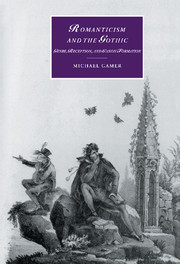Book contents
- Frontmatter
- Contents
- Acknowledgments
- List of abbreviations
- A note on the text
- Introduction: Romanticism's “pageantry of fear”
- 1 Gothic, reception, and production
- 2 Gothic and its contexts
- 3 “Gross and violent stimulants”: producing Lyrical Ballads 1798 and 1800
- 4 National supernaturalism: Joanna Baillie, Germany, and the gothic drama
- 5 “To foist thy stale romance”: Scott, antiquarianism, and authorship
- Notes
- Index
- CAMBRIDGE STUDIES IN ROMANTICISM
Introduction: Romanticism's “pageantry of fear”
Published online by Cambridge University Press: 22 September 2009
- Frontmatter
- Contents
- Acknowledgments
- List of abbreviations
- A note on the text
- Introduction: Romanticism's “pageantry of fear”
- 1 Gothic, reception, and production
- 2 Gothic and its contexts
- 3 “Gross and violent stimulants”: producing Lyrical Ballads 1798 and 1800
- 4 National supernaturalism: Joanna Baillie, Germany, and the gothic drama
- 5 “To foist thy stale romance”: Scott, antiquarianism, and authorship
- Notes
- Index
- CAMBRIDGE STUDIES IN ROMANTICISM
Summary
There is an economy of cultural goods, but it has a specific logic… To the socially recognized hierarchy of the arts, and within each of them, of genres, schools or periods, corresponds a social hierarchy of the consumers. This predisposes tastes to function as markers of “class.”
(Pierre Bourdieu, Distinction)I submit for your consideration the following hypothesis: a text cannot belong to no genre, it cannot be without or less a genre. Every text participates in one or several genres, there is no genreless text; there is always a genre and genres, yet such participation never amounts to belonging.
(Jacques Derrida, “The Law of Genre”)Since the 1980s, critics like Stuart Curran, Jacques Derrida, and Tzvetan Todorov have stated in various ways and without qualification that genre “is the driving force of … all literary history” – that “there is no genreless text.” This book does not seek to oppose such assertions so much as to explore their less-acknowledged corollary: that generic classification also depends upon the readers, publishers, and critics who ultimately determine a text's identity and value. The interplay between writers and readers drives not only Bourdieu's sense of canon formation and Derrida's final caution concerning “participation” and “belonging,” but also Fredric Jameson's definition of genre as a “social contract” occurring between any “writer and a specific reading public.”
- Type
- Chapter
- Information
- Romanticism and the GothicGenre, Reception, and Canon Formation, pp. 1 - 26Publisher: Cambridge University PressPrint publication year: 2000



